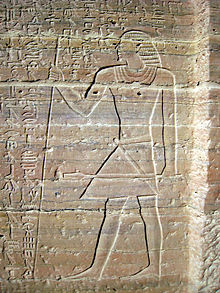 Global Information
Global InformationAutobiography of Harkhuf information
| Harkhuf | |
|---|---|
| Nomarch of the 1st nomos of Upper Egypt | |
 Harkhuf in a relief from his tomb at Qubbet el-Hawa. | |
| Successor | possibly Heqaib |
| Dynasty | 6th Dynasty |
| Pharaoh | Merenre I, Pepi II |
| Burial | Qubbet el-Hawa, Tomb 34 |
The Autobiography of Harkhuf is a private tomb inscription from ancient Egypt. It is significant in Egyptology as one of the two most important, and the most famous, autobiographical inscriptions of Old Kingdom officials.[1]
His name sometimes spelled as Herkhuf, Horkhuf, or Hirkhuf, all that is known of his life comes from the inscriptions in his tomb at Qubbet el-Hawa on the west bank of the Nile at Aswan, near the First Cataract of the Nile. He was a native of Elephantine. Harkhuf served under kings Merenre I, fourth king of the 6th Dynasty (ca. 2255–2246 B.C.),[2] and Pepi II, the last powerful king of the 6th Dynasty (ca. 2246–2152 B.C.).[2] He was appointed governor of Upper Egypt. His primary business was trade with Nubia,[3] forging political bonds with local leaders,[3] and preparing the ground for an Egyptian expansion into Nubia. He led four major expeditions to Nubia. His written account of these expeditions is the most important source for Egypt's relations with Nubia at this time.[1] On the last expedition, he brought back with him what his correspondence with the young pharaoh Pepi II referred to as a dwarf, apparently a pygmy.[4]
He travelled a considerable distance to a land called Iyam, which probably corresponds to the fertile plain that opens out south of modern Khartoum, where the Blue Nile joins the White. However, Jean Yoyotte thought Iyam was located further north in the Libyan Desert.[5]
The inscriptions in Harkhuf's tomb reflect changes in the Egyptian world view that were occurring during the Late Old Kingdom and the First Intermediate Period, with the person of the king becoming more human and displaying emotions and interests,[6] while commenting on a person leading a moral life by helping his neighbour: "I gave bread to the hungry, clothing to the naked, I ferried him who had no boat."[7]
- ^ a b Lichtheim, Miriam (2006). The Old and Middle Kingdoms. Berkeley: University of California Press. p. 23. ISBN 9780520248427. OCLC 889165092.
- ^ a b "List of Rulers of Ancient Egypt and Nubia | Lists of Rulers | Heilbrunn Timeline of Art History". The Met's Heilbrunn Timeline of Art History. The Metropolitan Museum of Art. Retrieved 2017-05-24.
- ^ a b Vernus, Pascal; Yoyotte, Jean (2003). The Book of the Pharaohs. Ithaca: Cornell University Press. p. 122. ISBN 0-8014-4050-5.
- ^ Vernus, Pascal; Yoyotte, Jean (2003). The Book of the Pharaohs. Ithaca: Cornell University Press. p. 74. ISBN 0-8014-4050-5.
- ^ Yoyotte, Jean (1953). Pour une localisation du pays de Iam. BIFAO 52 (in French). Cairo: Bulletin de l’Institut français d’archéologie orientale. pp. 173–178.
- ^ Karenga, Maulana (2004). Maat, the Moral Ideal in Ancient Egypt: A Study in Classical African Ethics. Routledge. p. 52. ISBN 0-415-94753-7.
- ^ Breasted, James Henry (1906). Ancient Records of Egypt. Vol. Part One. Chicago: University of Chicago Press.